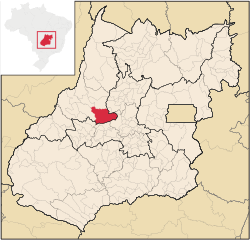Goiás Velho
| Município de Goiás "Cidade de Goiás"
Goiás Velho
|
|||
|---|---|---|---|
|
View of Goiás, in the middle the Igreja de Nossa Senhora do Rosário
|
|||
|
|
|||
| Coordinates | 15 ° 56 ′ S , 50 ° 9 ′ W | ||
 Location of the municipality in the state of Goiás Location of the municipality in the state of Goiás
|
|||
| Symbols | |||
|
|||
| founding | 1729 as the district of Arraial de Sant'Anna (291 years) 1736 as Vila de Boa Vista de Goiaz September 17, 1818 as Cidade de Goiás (201 years) |
||
| Basic data | |||
| Country | Brazil | ||
| State | Goiás | ||
| ISO 3166-2 | BR-GO | ||
| height | 496 m | ||
| climate | tropical, Aw | ||
| surface | 3108 km² | ||
| Residents | 24,727 (2010) | ||
| density | 8 Ew. / km² | ||
| estimate | 22,645 (July 1, 2019) | ||
| Parish code | IBGE : 5208905 | ||
| Post Code | 76600-000 | ||
| Telephone code | (+55) 62 | ||
| Time zone | UTC −3 | ||
| Website | prefeituradegoias (Brazilian Portuguese) | ||
| politics | |||
| City Prefect | Selma Bastos (2017-2020) | ||
| Political party | PT | ||
| Culture | |||
| City festival | July 25th (capital) | ||
| economy | |||
| GDP | 410,958 thousand R $ 16,933 R $ per person (2016) |
||
| HDI | 0.709 (2010) | ||
Goiás Velho , officially Portuguese Município de Goiás , also Cidade de Goiás and formerly just Goiás , is an old baroque city in the Brazilian state of Goiás . It is located west of the Brazilian capital Brasília and northwest of the capital Goiânia . The distance to Brasilia is approx. 300 km via the radial federal road BR-070 and approx. 150 km to Goiânia via the state road GO-070 . The population was estimated on July 1, 2019 at 22,645 inhabitants. This is slightly down from the 2010 census with 24,727 inhabitants. They live on a large community area of around 3108 km² and are called Goianos. The parish ranks 41st of the state's 246 municipalities.
In the municipality of Goiás Velho there are still the villages of Buenolândia , Calcilândia, Davidópolis, São João and Uvá.
Geography and climate
Goiás is located in a hilly to mountainous area, embedded in the foothills of the Serra Dourada , famous in Brazil , on the Rio Vermelho .
The climate is hot and humid. The vegetation is accordingly very varied.
Directions
The city is located 149 km from Goiânia on the BR-070 / GO-070. Buses run regularly from Goiânia and Brasília .
history
In 1682, the area around today's city, which was then inhabited by Indios from the Goyaz tribe, was visited for the first time by Europeans, namely by the bandeirante Bartolomeu Bueno da Silva (the "Annexuera"), who was looking for gold and Was diamonds. From 1727 the Santa Anna chapel was built as the center of the village of Vila de Sant'Ana , which was renamed to Vila Boa de Goyaz in 1732 . It was given this name in honor of the first visitor ( Bueno is a Spanish word that means Bom / Boa in Portuguese ) and in honor of the native people. At the same time the town got its own administration and government, but still belonged to the São Paulo captaincy .
On November 8, 1744, the Gomarca de Goiaz was separated from São Paulo and has been called Capitania Geral since then . On September 17, 1818 Goiaz was promoted to city and became the capital of the Goiaz Province.
On March 23, 1937, the seat of the state of Goiás was moved to Goiânia.
In 2001 the historical center of Goiás, the Centro Histórico de Goiás , in the UNESCO - World Heritage List was added.
See also: Buenolândia
economy
In addition to agriculture and animal husbandry, the exploitation of mineral resources (gold, precious stones, lime, silver, sulfur, copper, etc.) are of great importance.
Worth seeing
About 90% of the original colonial baroque architecture has been preserved; the old town has been a listed building since the 1950s. Goiás is therefore a reflection of the architecture of 18th century Brazil and the boom in gold mining. In addition, it is embedded in a very pretty landscape.
The city has 18 Catholic and ten Protestant churches, mostly Baroque buildings, which are of interest to visitors (including Igrejas da Boa Morte , Igreja de Santa Bárbara , Igreja de Nossa Senhora do Carmo , Igreja da Abadia , Igreja de São Francisco ). There are also several museums for sacred art.
A special occasion to visit the city is during the week of Semana Santa (Easter). The processions take place with torches and masked figures.
Photo gallery
Personalities
- Cora Coralina (1889–1985), writer and poet
- Juvenal Roriz (1920–1994), Archbishop of Juiz de Fora
See also
literature
- Goyáz . In: Encyclopædia Britannica . 11th edition. tape 12 : Gichtel - harmonium . London 1910, p. 303–304 (English, full text [ Wikisource ]).
Web links
- Entry on the UNESCO World Heritage Center website ( English and French ).
- City Prefecture website , Prefeitura Municipal (Brazilian Portuguese)
- City Council website , Câmara Municipal (Brazilian Portuguese)
Individual evidence
- ↑ Goiás climate: average temperature, weather by month, Goiás weather averages. In: de.climate-data.org. Retrieved October 17, 2019 .
- ↑ a b c Goiás - Panorama. In: cidades.ibge.gov.br. IBGE , accessed October 17, 2019 (Brazilian Portuguese).
- ^ Professora Selma Bastos 13 (Prefeita). In: todapolitica.com. Eleições 2016, accessed October 17, 2019 (Brazilian Portuguese).
- ↑ Entry on the website of the UNESCO World Heritage Center ( English and French ).










